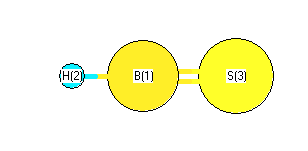Vibrational Frequencies calculated at MP2=FULL/aug-cc-pVQZ
| Mode Number |
Symmetry |
Frequency
(cm-1) |
Scaled Frequency
(cm-1) |
IR Intensities
(km mol-1) |
Raman Act
(Å4/u) |
Dep P |
Dep U |
|---|
| 1 |
Σ |
2888 |
2762 |
19.71 |
61.37 |
0.22 |
0.36 |
| 2 |
Σ |
1202 |
1150 |
37.30 |
94.34 |
0.08 |
0.15 |
| 3 |
Π |
728 |
696 |
0.04 |
1.07 |
0.75 |
0.86 |
| 3 |
Π |
728 |
696 |
0.04 |
1.07 |
0.75 |
0.86 |
Unscaled Zero Point Vibrational Energy (zpe) 2772.7 cm
-1
Scaled (by 0.9564) Zero Point Vibrational Energy (zpe) 2651.8 cm
-1
See section
III.C.1 List or set vibrational scaling factors
to change the scale factors used here.
See section
III.C.2
Calculate a vibrational scaling factor for a given set of molecules
to determine the least squares best scaling factor.
